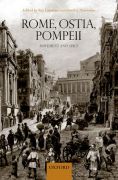
Studies of the Roman city are currently shifting away from architecture towards a dynamic understanding of activities within the urban space. This volume focuses on the movement or flow of a Roman city's inhabitants and visitors, demonstrating how it contributes to our understanding of the way different elements of society interacted in space. Rome, Ostia, Pompeii: Movement and Space demonstrates how studies of the Roman city are shifting focus from static architecture to activities and motion within urban spaces. This volume provides detailed case studies from the three best-known cities from Roman Italy, revealing how movement contributes to our understanding of the ways different elementsof society interacted in space, and how the movement of people and materials shaped urban development. The chapters in this book examine the impressions left by the movement of people and vehicles as indentations in the archaeological and historical record,and as impressions upon the Roman urban consciousness. Through a broad range of historical issues, this volume studies movement as it is found at the city gate, in public squares and on the street, and as it is represented in texts. Its broad objective is to make movement meaningful for understanding the economic, cultural, political,religious, and infrastructural behaviours that produced different types and rhythms of interaction in the Roman city. This volume's interdisciplinary approach will inform the understanding of the city in classics, ancient history, archaeology, and architectural history, as well as cultural studies, town planning, urban geography, and sociology. INDICE: Dedication Table of contents Preface Acknowledgments Notes on Contributors Introduction Making Movement Meaningful Part I: Articulating Movementand Space Movement and the Linguistic Turn: Reading Varro s de Lingua Latina Literature and the Spatial Turn: Movement and Space in Martial s Epigrams Measuring spatial visibility, adjacency, permeability and degrees of street life in Pompeii Towards a Multisensory Experience of Movement in the City of Rome Part II: Movement in the Roman city: infrastructure and organisation The Power of Nuisances on the Roman Street Pes dexter: Superstition and the state in the shaping of shop-fronts and street activity in the Roman world Cart Traffic Flow in Pompeii and Rome Where to Park? Carts, Stables and the Economics of Transport in Pompeii The Spatial Organisation of the Movement Economy: The Analysisof Ostia s scholae Part III: Movement and the Metropolis The Street Life of Ancient Rome The City in Motion: Walking for transport and leisure in the city of Rome Movement and Fora in Rome (the Late Republic to the first century CE) Movement, gaming and the use of space in the forum Construction Traffic in Imperial Rome: Building the Arch of Septimius Severus Movement and urban development at two city gates in Rome: the Porta Esquilina and Porta Tiburtina Endpiece From Movement to Mobility: Future Directions Bibliography
- ISBN: 978-0-19-958312-6
- Editorial: Oxford University
- Encuadernacion: Cartoné
- Páginas: 464
- Fecha Publicación: 24/11/2011
- Nº Volúmenes: 1
- Idioma: Inglés
